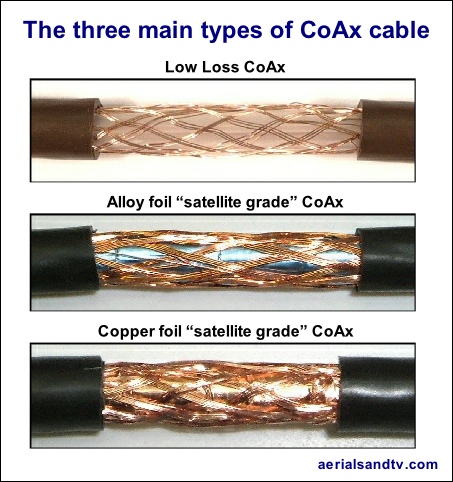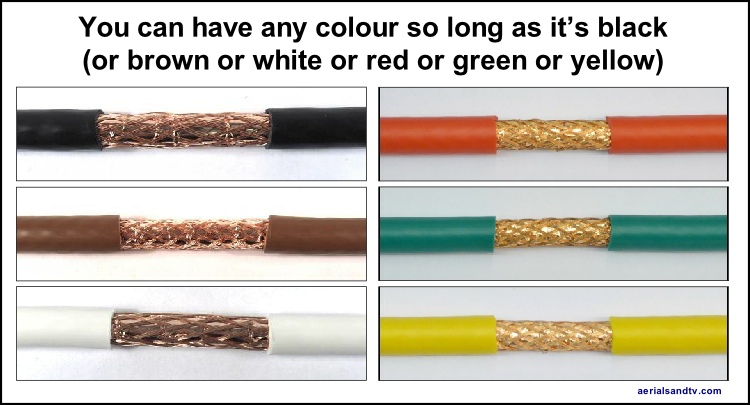The Three Main Types Of CoAx Cable
Parent page = Cable, leads and connectors
Subject list :
- "Low Loss" CoAx
- Alloy foil type "satellite" cable
- Copper foil type "satellite" cable
Plus :
- HD “triple screened” cable
- 50Ω specialist cable
- Twin satellite cable ("Shotgun" cable)
All TV, FM, DAB, and/or satellite downlead should be 75 Ohm impedance* in order to maintain an "impedance matched system", but there are 3 main types of RF coaxial cable :
“Low Loss” CoAx
(note the low percentage screening cover)
Poor screening.
Reasonable life ?
Alloy foil type “satellite cable”
(note the aluminium screening foil).
Decent screening.
Suspect life ?
Copper foil type “satellite cable”
(note the copper screening foil)
The best screening.
The longest life.
* The impedance of the cable is mainly dependent on the ratio between the diameter of the inner conductor and the inside diameter of the outer conductor.

"Low Loss" CoAx
(We do not sell this type of cable)

Traditionally everyone used "Low Loss CoAx" for virtually all TV (and FM radio) aerial cable and years ago much of the CoAx on the market was of pretty reasonable quality with high percentage screening cover. The vast majority of low loss Coaxial cable sold these days is absolute rubbish. This is an objective fact and can be proved by just looking at the exposed screening in the picture above. There’s probably only 40% screening coverage on 42 strand "budget low loss CoAx". Don’t get me wrong, if you live in a reasonable reasonable signal area and/or the downlead isn’t too long, and/or you’re lucky, it could still work reasonably well, though if the cable is old thin stuff, (i.e. less than 6mm) it really should be changed if possible.
Signal loss is one thing but cheap cable’s real Achilles heel is poor interference suppression. With particular reference to the "Digital cliff edge" it’s just not worth skimping on the cable to save a few of quid. If decent cable prevents just one glitch/freeze on your picture per night (for the next 20 years......) it really is [or should be] a no brainer. How much did your TV cost ?
These days virtually no aerial installers use low loss CoAx, even the Bodgers don’t (usually).
The high power 4G/5G transmissions make good screening even more important, be warned !
Most new build houses used to use ultra cheap CoAx to wire up the pre-installed TV points, and some still do. If you have any input into the build of your house, I would insist on the use of decent cable. Quite apart from the superior performance of satellite cable at TV/UHF frequencies, you never know whether you (or someone who buys your house) may need to utilise existing wiring to transmit signals at satellite frequency, see Diplexers. I’m sure electricians know more than us about "ring mains", but, with respect, we know more than they do about RF. So take our advice and don’t let them fob you off.
In my opinion these days nobody should be fitting (or even selling) "Low Loss" coaxial cable.
The vast majority of brown (or sometimes white) downlead is of the budget Co-Ax variety, though (just to make things even more complicated....) we actually stock copper/copper satellite cable in brown as well as black & white (and yellow and red and green....) ! A more positive check can be made by taking off the plug and closely examining for the presence of an additional screening sheath. If it has all been trimmed off, the latter may not be visible under the outer insulation so removing a small section of this may be necessary.
Typical loss (per 10m at 800MHz) of "Low Loss" CoAx is approx 2.7dB, i.e. a typical 15m run would lose just over 4dB (a 6dB loss is half )
Alloy Foil Type "RG6" Satellite Cable
(We do not sell this type of cable)

This is the lower quality grade of satellite cable, but even the cheapest is far better than "budget low loss" CoAx. The major difference between satellite cable and "low loss" Co-Ax is the addition of a layer of screening foil just under the braiding, i.e. (for simplification) it’s "double screened". The latter can have a big effect in helping to minimise interference and decrease loss.
The high power 4G/5G transmissions make good screening even more important, be warned !
With RG6 type cable the foil is usually aluminium or some similar material, although the cheaper brands seem to use a mylar film sprayed with conductive paint. To be quite honest it’s perfectly suitable for virtually all TV/Radio (i.e. UHF/VHF) applications and this is particularly true if it is a branded product, e.g. Webro. Although Sky don’t (didn’t would be more accurate, they’re more bothered about the cost now ! ) recommend this grade of cable this is more to do with the fact that RG6 type cable doesn’t last as long as copper/copper type cable because the braiding on alloy foil type type cable can oxidise over time (dissimilar metals), particularly if used outdoors. Apart from that I would say that RG6 is fine for most satellite use provided the down lead is not of excessive length. Almost all aerial installers use RG6 cable these days because it’s far better than "Low Loss" but doesn’t actually cost that much more. On the other hand RG6 is much cheaper than the (superior) copper/copper type, thus explaining why so few use the latter......
Note, RG6 is technically the size of the cable (i.e. 6mm in diameter), and as such most Co-Ax cables are also RG6, but to most in the trade RG6 has come to mean alloy foil satellite cable, because it’s a lot easier than saying “alloy foil type satellite coaxial cable” !
Typical loss (per 10m at 800MHz) of RG6 type cable is about 1.9 dB, i.e. a typical 15m run would lose just under 3 dB (a 6dB loss is half )
Copper Foil Type Satellite Cable
(We only sell this type of cable)

The third type of cable also has "double screening", but this time the foil is copper. The WF100 grade of cable that we sell is the best of the generally available types, though when I say generally available it’s not sold at DIY shops.
The high power 4G/5G transmissions make good screening even more important, be warned !
To be frank, this cable is overkill for DAB/FM (i.e. VHF) but being a perfectionist I like that. There isn’t a big difference in attenuation between copper foil and alloy foil (RG6 type) cable on UHF [or even satellite], but copper/copper cable lasts significantly longer, which is why (at one time) Sky only recommended this grade, but with higher "churn rates", the huge increase in the price of copper, and their desire to make as much as poss, they’re not quite so fussy anymore ! Whatever the pros and cons, the price difference on a typical 15m run is only a few pounds, so why not fit the best ?
Hardly any aerial installers use copper/copper satellite cable, and even fewer use WF100, the vast majority use RG6 because it’s a lot cheaper, remember they’re using loads of it so it makes a significant difference to how much money they make. Thus, if you have to get an installer to run your cable(s), but you want to ensure copper/copper is fitted, I’d buy it yourself and then get them to fit it, but (discretely......) make sure they fit the cable you’ve bought !
This cable is suitable for FM, DAB, TV and Satellite, and it is CAI / Sky approved. Our cable is the foam filled type as opposed to air spaced. Although signal quality wise there’s no difference between them, foam filled tends to resist kinking slightly better. Furthermore if you’re unlucky enough to get water into the cable then foam filled tends to resist water running down the inside of it better than air spaced, though it can still permeate down through the outer braiding under certain conditions. Cable diameter 6.7mm (average).
NOTE (and I only found this out in Dec 2023 ! ) only the centre conductor of CT100 is pure copper. The braid and the foil is copper clad aluminium. Hence the fact it's cheaper. We sell WF100 which is pure copper throughout.
Remember, if decent cable prevents just one glitch/freeze on your picture per night (for the next 20 years........) it really is a no brainer, or it should be.
Typical loss (per 10m at 800MHz) for this type of cable is 1.8 dB, i.e. a typical 15m run would lose just over 2.5dB (a 6dB loss is half )
Of interest is some research we did for a customer of ours into the loss of WF100 v RG11 :
Loss per 100m at 500MHz and 1000MHz
WF100 = 15.5dB and 21.5dB
RG11 = 16.9dB and 25.5dB
We sell copper/copper satellite grade cable in black, white, brown, red, yellow and green, by the metre, or by the reel, 50m or 100m.

Actually, there is a fourth type of cable, “triple screened” HD Coax cable, e.g. HD100. I have to say I’m dubious about how worthwhile this product is, particularly as standard F connectors don’t even fit it. Bear in mind that in our impulse interference tests there was no significant RF noise admitted even to the cheaper lower quality RG6 (alloy screening foil) type cable. Copper/copper cable (best type = WF100) is one stage better than that and in addition, as discussed above, doesn’t have the susceptibility to dissimilar metals oxidation of the RG6. Lastly, but just as importantly, HD100 has the same loss / attenuation (29.0dB per 100m at 1750MHz) as WF100 ! So, I have to say, I can’t really see the point of HD100, thus, we don’t stock it. Obviously if you’ve got a load of it free (and the connectors of course ! ) then by all means use it, but I personally don’t think there’s any significant difference.
There is another type of CoAx used in RF transmission / reception, 50 Ohm (50Ω) cable. It must be stressed this is not suitable for TV / FM / DAB / satellite installs, as we have seen the latter use 75Ω cable, using 50Ω would give an impedance mismatch. 50Ω cable is generally used for amateur radio type jobs.

